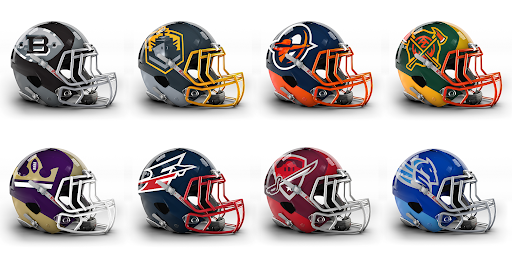Alliance of American Football Guide
On what is usually a dark and dreary weekend for football fans the week after the Super Bowl, a new hero has stepped out of the shadows. Enter, the Alliance of American Football (AAF).
The new developmental semi-professional league started this weekend surpassing expectations set by most professional football analysts and fans alike. The AAF’s inaugural game on Saturday was even originally reported to have beaten out the NBA in viewer ratings.
Sources: In its debut night last night, @theaaf beat the NBA on ABC in head-to-head overnight ratings:
AAF Games (2 games, 1 per market): 2.1
Houston-OKC game: 2.0
— Darren Rovell (@darrenrovell) February 10, 2019
How It All Started
The league was founded by Charlie Ebersol and Bill Polian. Charlie Ebersol’s father, Dick, was a co-founder of the original XFL league while Polian is a former NFL general manager. The concept of this league was to create something that worked in conjunction with the NFL as opposed to competing against it. A
The AAF is littered with former NFL personnel in its executive leadership group with notable names such as former Steelers Troy Polamalu and Hines Ward as Head of Player Relations and Head of Football Development respectively. They also have Mike Pereira and Dean Blandino as officiating consultants.
Teams and Divisions
There are eight teams in the AAF divided between two divisions, Western Conference and the Eastern Conference. The teams are:
WEST
- Arizona Hotshots
- Salt Lake Stallions
- San Antonio Commanders
- San Diego Fleet
EAST
- Atlanta Legends
- Birmingham Iron
- Orlando Apollos
- Memphis Express
The league made it a priority to recruit players heavily who have local ties to their team’s region such as former college athletes. Some coaches you may recognize from the NFL as well such as SD Fleet head coach and former Rams “Greatest Show on Turf” era coach, Mike Martz.
Differences Between NFL and AAF
The AAF is trying to set a tone as an example of the progressive moves that the NFL needs to make to enhance the viewer experience. Some major rule differences are:
- No kickoffs, the ball is spotted at the 25-yard line.
- Two-point conversion attempts instead of extra points after a TD.
- 4th & 12 conversion attempt replaces onside kicks.
- Blitz limitations (only five-man rush allowed).
- 35-second play clock.
- No TV timeouts.
- Overtime: One possession for each team from the opponents 10-yard line, no ties.
The pace of play is noticeably faster in the AAF, in fact, it’s almost too fast. You don’t really have time to digest the play that just happened before they’re on to the next one. Also, with no kickoffs, there is virtually no break in between a TD and the opposing team taking over the ball. Teams can still attempt field goals obviously but the league has almost erased kickers from the game script completely. To be honest, I don’t really miss them when it comes to kickoffs or extra points. Sorry, kickers. The mandatory two-point conversion attempt is a pretty exciting aspect from both a real-life perspective and a fantasy perspective. Despite the blitz limitations, QBs were still getting lit up in Week 1, just ask SD Fleet QB Mike Bercovici.
Welcome to every AAF promo reel, Mike Bercovici pic.twitter.com/9xHi9e1p39
— Big Cat (@BarstoolBigCat) February 10, 2019
Poor guy, it was his birthday too. There were noticeably fewer flags thrown in the first week of AAF play compared to the NFL as the league went with a “let them play” mentality. Another big hit amongst the viewing crowd was the introduction of the “sky judge”. Basically, you get a front row seat watching the officials in the booth go through their process of evaluating plays in an attempt to prevent missed calls on the field. Here’s an example:
In the AAF: Sky judge tells field judge what’s the ruling on the field during a replay review. You even get to listen in. pic.twitter.com/nir4eT2BNq
— NFL Update (@MySportsUpdate) February 10, 2019
Another notable difference in this league is that every player gets paid the same $70k salary this season. There is no griping and whining about not getting paid enough and who deserves more money than who. Everyone is here for the same reason, to get to that next level. To keep fighting to play the sport they love for a living.
Fantasy Interaction
This is my only gripe with the start of the AAF. They completely missed the boat on creating any sort of official fantasy platform. They boast a ground-breaking interactive app (that didn’t quite work well in Week 1) yet did not get an actual site to host fantasy leagues. An independent developer took it upon himself to create one at AltFantasySports.com. There was a massive response to this site with thousands of leagues created over a matter of days.
There are also weekly DFS tournaments offered over at Fanball.com. The other part of the start of this league that is frustrating from a fantasy perspective is the lack of official statistical information. Again, this is an aspect the league had promoted to no end leading up to Week 1 that they have all of this next level, advanced statistical information they will be putting out. Yet, through the weekend and into Monday afternoon there wasn’t as much as a single boxscore available through either the league’s site or the official team pages. Luckily, one man at NoExtraPoints.com took it upon himself to offer this information for free.
Conclusion
I’m all in on the AAF. I think the product on the field for Week 1 was great and has a lot of room to grow. It wasn’t quite as polished as we see in the NFL for the most part, but there is plenty of potential here. It is just hard not to root for every player here as well in a league of underdogs. There will be kinks, there’s going to

